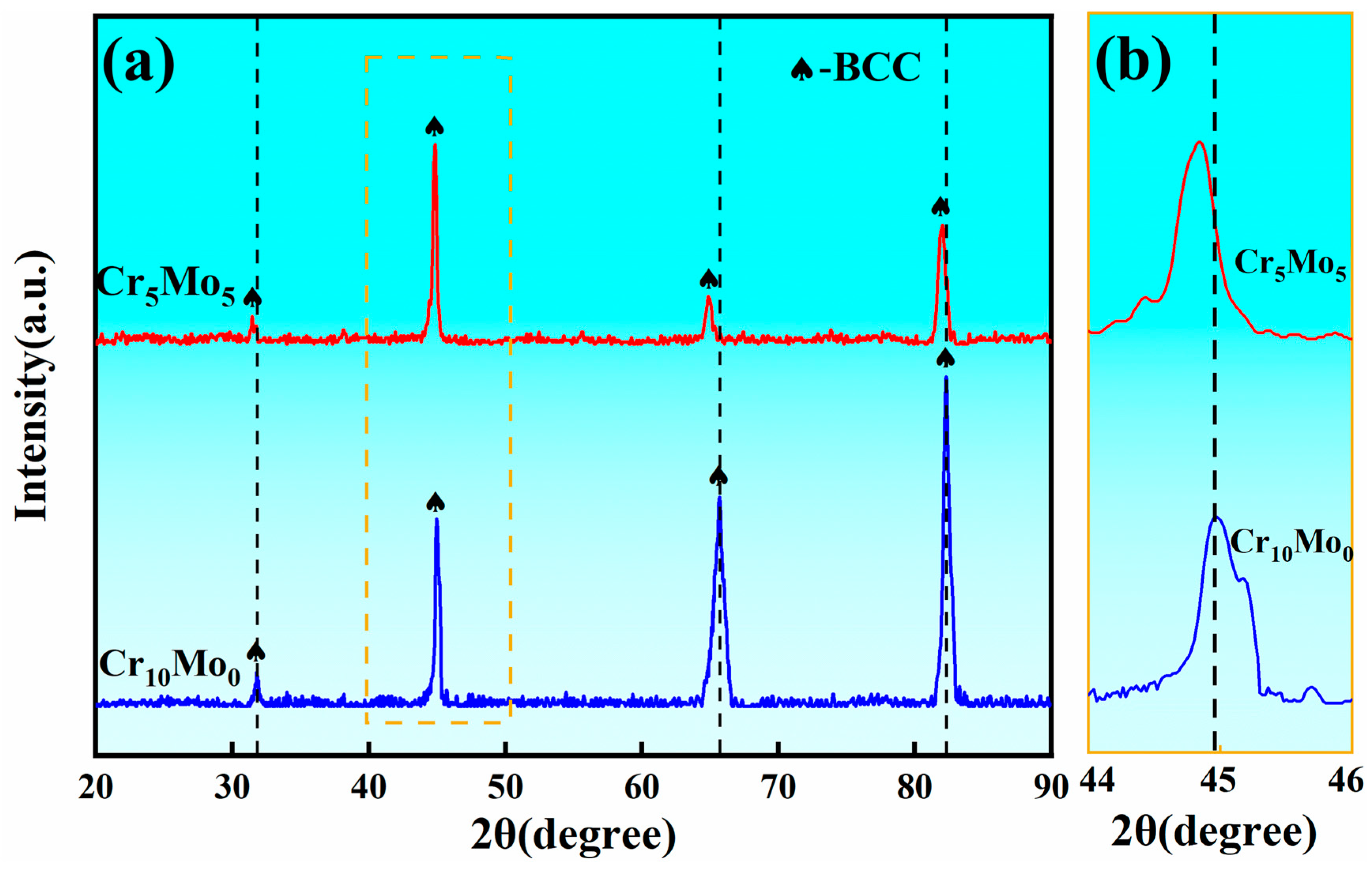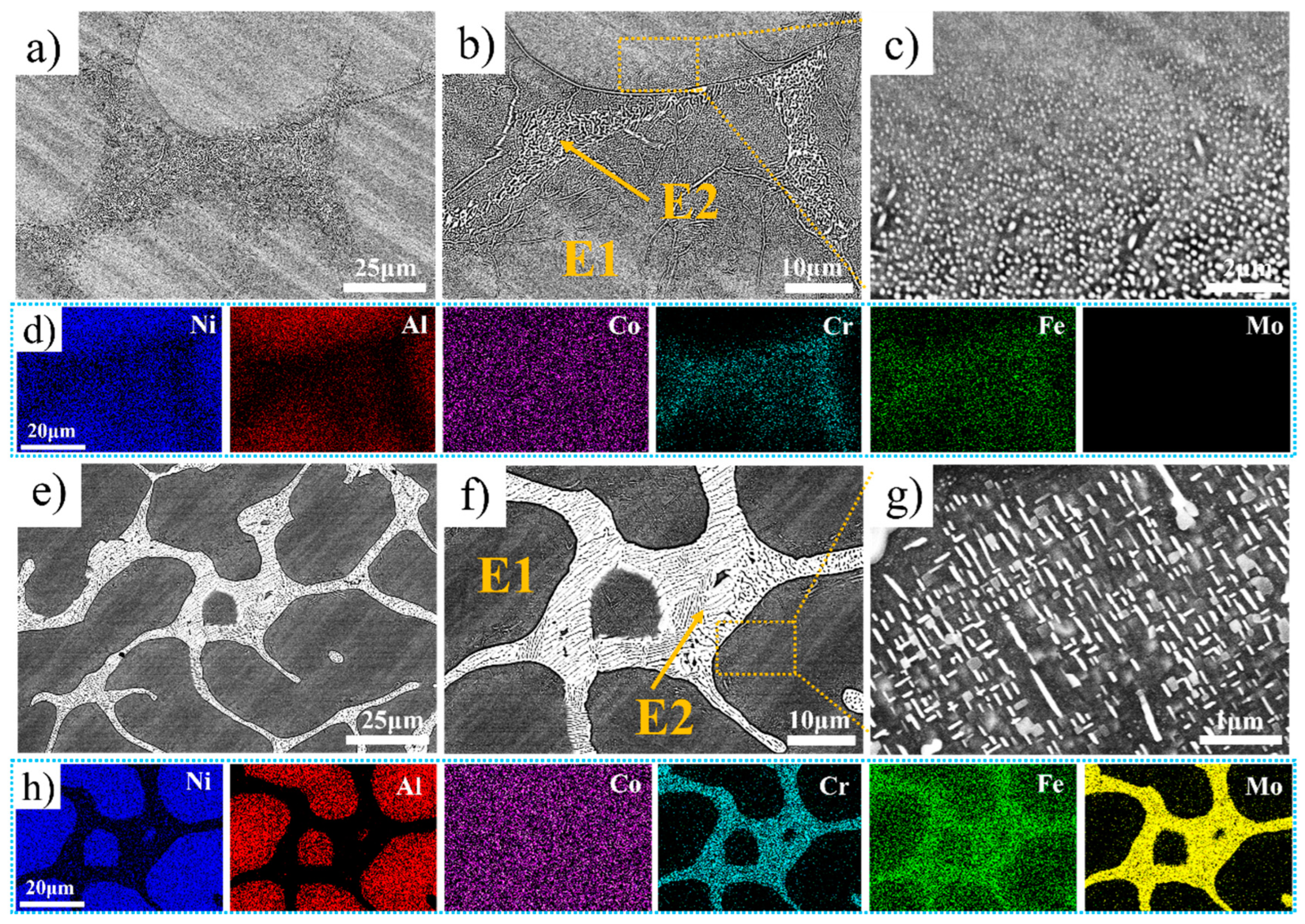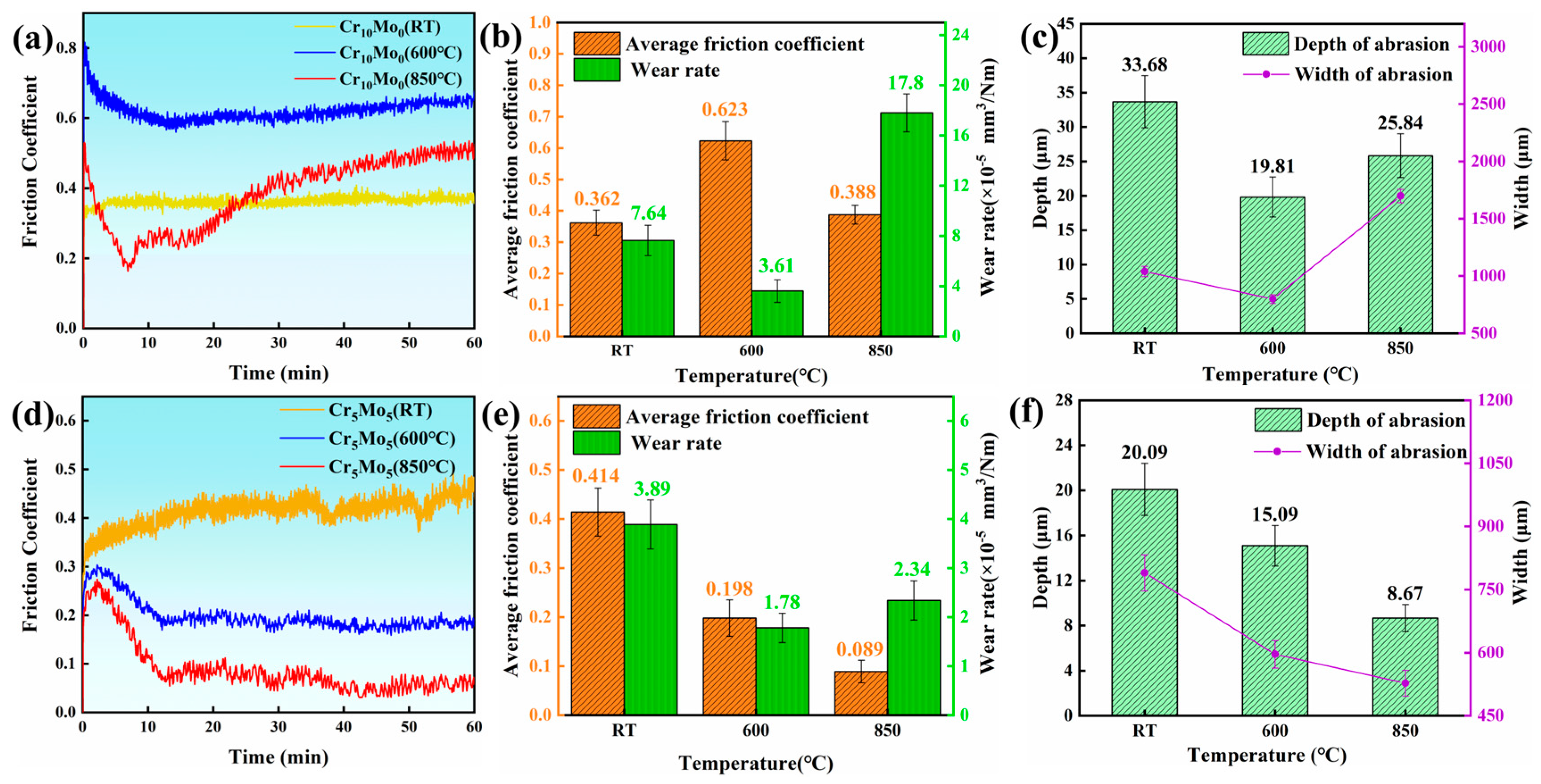Microstructure, Mechanical Properties, and Corrosion Resistance of NiAl-CoCrFeMo High-Entropy Alloys by Controlling Mo Co-Doping
Abstract
1. Introduction
2. Experimental Procedures
2.1. Alloy Composition Design
2.2. Sample Preparation
2.3. Microstructural Characterization
2.4. Mechanical and Wear Tests
2.5. Electrochemical Tests
3. Results and Discussion
3.1. Microstructural Evolution and Phase Composition
3.2. Compressive Performance and Friction and Wear Performance of Alloys at Different Temperatures
3.3. Corrosion Performance
4. Conclusions
Author Contributions
Funding
Institutional Review Board Statement
Informed Consent Statement
Data Availability Statement
Conflicts of Interest
References
- Du, X.H.; Gao, C.; Wu, B.L.; Zhao, Y.H.; Wang, J.J. Enhanced Compression Ductility of Stoichiometric NiAl at Room Temperature by Y and Cu c-Co-addition. Int. J. Miner. Metall. Mater. 2012, 19, 348–353. [Google Scholar] [CrossRef]
- Bochenek, K.; Basista, M. Advances in processing of NiAl intermetallic alloys and composites for high temperature aerospace applications. Prog. Aerosp. Sci. 2015, 79, 136–146. [Google Scholar] [CrossRef]
- Wang, L.; Gao, L.; Shen, J.; Zhang, Y.; Liu, G.; Zhao, P.; Zhang, G. Eutectic Composition Design, Microstructure, and Room Temperature Mechanical Property of NiAl-Cr-Ta Three-Phase Alloy. Metall. Mater. Trans. A 2022, 53, 1479–1485. [Google Scholar] [CrossRef]
- Wang, D.; Ning, H.; Wang, B.; Liu, G.; Yuan, S. Fabrication of a NiAl-Cr(Mo) Eutectic Alloy with Network Microstructure for High-Temperature Strengthening. Mater. Sci. Eng. A 2022, 835, 142628. [Google Scholar] [CrossRef]
- Wang, L.; Yao, C.; Shen, J.; Zhang, Y.; Wang, T.; Xu, H.; Gao, L.; Zhang, G. Microstructures and Compressive Properties of NiAl-Cr (Mo) and NiAl-Cr Eutectic Alloys with Different Fe Contents. Mater. Sci. Eng. A 2019, 744, 93–603. [Google Scholar] [CrossRef]
- Li, Z.; Pradeep, K.G.; Deng, Y.; Raabe, D.; Tasan, C.C. Metastable high-entropy dual-phase alloys overcome the strength-ductility trade-off. Nature 2016, 534, 227–230. [Google Scholar] [CrossRef]
- George, E.P.; Raabe, D.; Ritchie, R.O. High-entropy alloys. Nat. Rev. Mater. 2019, 4, 515–534. [Google Scholar] [CrossRef]
- Miracle, D.B.; Senkov, O.N. A critical review of high entropy alloys and related Concepts. Acta Mater. 2017, 122, 448–511. [Google Scholar] [CrossRef]
- Huo, W.; Zhou, H.; Fang, F.; Zhou, X.; Xie, Z.; Jiang, J. Microstructure and properties of novel CoCrFeNiTax eutectic high-entropy alloys. J. Alloys Compd. 2018, 735, 897–904. [Google Scholar] [CrossRef]
- Chen, B.; Li, Z.B.; Liu, J.R.; Zhang, G.H. Effect of molybdenum addition on microstructure and mechanical properties of 90% tungsten heavy alloys. Int. J. Refract. Met. Hard Mater. 2022, 106, 105868. [Google Scholar] [CrossRef]
- Chuang, M.H.; Tsai, M.H.; Wang, W.-R.; Lin, S.J.; Yeh, J.W. Microstructure and wear behavior of AlxCo1.5CrFeNi1.5Tiy high-entropy alloys. Acta Mater. 2011, 59, 6308–6317. [Google Scholar] [CrossRef]
- Addepalli, S.N.; Joladarashi, S.; Ramesh, M.R. Phase evolution and high-temperature wear behavior of non-equiatomic metastable CoCrNiTiMox HEA coatings fabricated by high-velocity oxy-fuel technique. Mater. Today Commun. 2023, 35, 106310. [Google Scholar] [CrossRef]
- Wang, J.; Zhang, Z.; Dai, H.; Fujiwara, H.; Chen, X.; Ameyama, K. Enhanced corrosion resistance of CoCrFeMnNi high entropy alloy using heterogeneous structure design. Corros. Sci. 2022, 209, 110761. [Google Scholar] [CrossRef]
- Han, F.; Li, C.Y.; Huang, J.Q.; Wang, J.C.; Xia, C.B.; Xue, L.; Wang, C.M. Effect of nitric acid concentration on corrosion behavior of CrFeCoNi high entropy alloy. Mater. Today Commun. 2024, 41, 110779. [Google Scholar] [CrossRef]
- Patnamsetty, M.; Ghosh, S.; Somani, M.C.; Peura, P. Dynamic softening kinetics of Al0.3CoCrFeNi high-entropy alloy during high temperature compression and its correlation with the evolving microstructure and micro-texture. Mater. Charact. 2023, 197, 112693. [Google Scholar] [CrossRef]
- Lu, Y.; Dong, Y.; Guo, S.; Jiang, L.; Kang, H.; Wang, T.; Wen, B.; Wang, Z.; Jie, J.; Cao, Z.; et al. A promising new class of high-temperature alloys: Eutectic high-entropy alloys. Sci. Rep. 2014, 4, 6200. [Google Scholar] [CrossRef]
- Wu, Y.D.; Cai, Y.H.; Chen, X.H.; Wang, T.; Si, J.J.; Wang, L.; Wang, Y.D.; Hui, X.D. Phase composition and solid solution strengthening effect in TiZrNbMoV high-entropy alloys. Mater. Des. 2015, 83, 651–660. [Google Scholar] [CrossRef]
- Zhang, X.; Li, R.; Huang, L.; Amar, A.; Wu, C.; Le, G.; Liu, X.; Guan, D.; Yang, G.; Li, J. Influence of in situ and ex situ precipitations on microstructure and mechanical properties of additive manufacturing CoCrFeMnNi high-entropy alloys. Vacuum 2021, 187, 110111. [Google Scholar] [CrossRef]
- Qin, G.; Chen, R.R.; Zheng, H.T.; Fang, H.Z.; Wang, L.; Su, Y.Q.; Guo, J.J.; Fu, H.Z. Strengthening FCC-CoCrFeMnNi high entropy alloys by Mo addition. J. Mater. Sci. Technol. 2019, 4, 578–583. [Google Scholar] [CrossRef]
- Wu, S.W.; Yang, T.; Cao, B.X.; Luan, J.H.; Jia, Y.F.; Xu, L.; Mu, Y.K.; Zhang, T.L.; Kong, H.J.; Tong, X.; et al. Multicomponent Ni-rich high-entropy alloy toughened with irregular-shaped precipitates and serrated grain boundaries. Scr. Mater. 2021, 204, 114066. [Google Scholar] [CrossRef]
- Liu, W.H.; Lu, Z.P.; He, J.Y.; Luan, J.H.; Wang, Z.J.; Liu, B.; Liu, Y.; Chen, M.W.; Liu, C.T. Ductile CoCrFeNiMox high entropy alloys strengthened by hard intermetallic phases. Acta Mater. 2016, 116, 332–342. [Google Scholar] [CrossRef]
- Zhuang, Y.X.; Zhang, X.L.; Gu, X.Y. Effect of molybdenum on phases microstructure and mechanical properties of Al0.5CoCrFeMoxNi high entropy alloys. J. Alloys Compd. 2018, 743, 514–522. [Google Scholar] [CrossRef]
- Miao, J.W.; Guo, T.M.; Ren, J.F.; Zhang, A.J.; Su, B.; Meng, J.H. Optimization of mechanical and tribological properties of FCC CrCoNi multi-principal element alloy with Mo addition. Vacuum 2018, 149, 324–330. [Google Scholar] [CrossRef]
- Wang, D.C.; Tao, X.P.; Zhang, S.; Wang, X.G.; Wu, C.L.; Zhang, C.H.; Chen, H.T.; Sun, X.F.; Zhou, Y.Z. Dependence of molybdenum content on the cavitation corrosion synergy and wear failure of laser cladded CoCrFeNiMnMo high entropy alloy coatings. Eng. Fail. Anal. 2024, 165, 108824. [Google Scholar] [CrossRef]
- Deng, G.Y.; Tieu, A.K.; Su, L.H.; Wang, P.; Wang, L.; Lan, X.D.; Cui, S.G.; Zhu, H.T. Investigation into reciprocating dry sliding friction and wear properties of bulk CoCrFeNiMo high entropy alloys fabricated by spark plasma sintering and subsequent cold rolling processes: Role of Mo element concentration. Wear 2020, 460–461, 203440. [Google Scholar] [CrossRef]
- Niu, Z.Z.; Wang, Y.Z.; Geng, C.; Xu, J.; Wang, Y. Microstructural evolution, mechanical and corrosion behaviors of as-annealed CoCrFeNiMox (x = 0, 0.2, 0.5, 0.8, 1) high entropy alloys. J. Alloys Compd. 2020, 820, 153273. [Google Scholar] [CrossRef]
- Chou, Y.L.; Yeh, J.W.; Shih, H.C. The effect of molybdenum on the corrosion behaviour of the high-entropy alloys Co1.5CrFeNi1.5Ti0.5Mox in aqueous environments. Corros. Sci. 2010, 52, 2571–2581. [Google Scholar] [CrossRef]
- Hsu, W.C.; Kao, W.P.; Yeh, J.W.; Tsai, C.W. Effect of Mo on the Mechanical and Corrosion Behaviors in Non-Equal Molar AlCrFeMnNi BCC High-Entropy Alloys. Materials 2022, 15, 751. [Google Scholar] [CrossRef]
- Wang, X.F.; Zhang, Y.; Qiao, Y.; Chen, G.L. Novel microstructure and properties of multicomponent CoCrCuFeNiTix alloys. Intermetallics 2007, 15, 357–362. [Google Scholar] [CrossRef]
- Guo, S.; Liu, C.T. Phase stability in high entropy alloys: Formation of solid-solution phase or amorphous phase. Prog. Nat. Sci. Mater. Int. 2011, 21, 433–446. [Google Scholar] [CrossRef]
- Chen, M.; Shi, X.H.; Yang, H.; Liaw, P.K.; Gao, M.C.; Hawk, J.A.; Qiao, J. Wear behavior of Al0.6CoCrFeNi high-entropy alloys: Effect of environments. J. Mater. Res. 2018, 33, 3310–3320. [Google Scholar] [CrossRef]
- Lan, L.W.; Yang, H.J.; Guo, R.P.; Wang, X.J.; Zhang, M.; Liaw, P.K.; Qiao, J.W. High-temperature sliding wear behavior of nitrided Ni45(CoCrFe)40(AlTi)15 high-entropy alloys. Mater. Chem. Phys. 2021, 270, 124800. [Google Scholar] [CrossRef]
- Li, Z.; Zhang, Z.; Liu, X.; Li, H.; Zhang, E.; Bai, G.; Xu, H.; Liu, X.; Zhang, X. Strength, plasticity and coercivity tradeoff in soft magnetic high-entropy alloys by multiple coherent interfaces. Acta Mater. 2023, 254, 118970. [Google Scholar] [CrossRef]
- Wang, L.; Wang, L.; Zhou, S.; Xiao, Q.; Xiao, Y.; Wang, X.; Cao, T.; Ren, Y.; Liang, Y.J.; Wang, L.; et al. Precipitation and micromechanical behavior of the coherent ordered nanoprecipitation strengthened Al-Cr-Fe-Ni-V high entropy alloy. Acta Mater. 2021, 216, 117121. [Google Scholar] [CrossRef]
- Chen, Z.X.; Ding, H.S.; Chen, R.R.; Guo, J.J.; Fu, H.Z. An innovation for microstructural modification and mechanical improvement of TiAl alloy via electric current application. Sci. Rep. 2019, 9, 5518. [Google Scholar] [CrossRef]
- Nguyen, C.; Tieu, A.K.; Deng, G.; Wexler, D.; Vo, T.D.; Wang, L.; Yang, J. Tribological performance of a cost-effective CrFeNiAl0.3Ti0.3 high entropy alloy based self-lubricating composite in a wide temperature range. Tribol. Int. 2022, 174, 107743. [Google Scholar] [CrossRef]
- Xiao, J.K.; Tan, H.; Wu, Y.Q.; Chen, J.; Zhang, C. Microstructure and wear behavior of FeCoNiCrMn high entropy alloy coating deposited by plasma spraying. Surf. Coat. Technol. 2020, 385, 125430. [Google Scholar] [CrossRef]
- Deng, G.; Dong, B.; Zhang, C.; Wang, R.; Yang, Z.; Nie, N.; Wang, P.; Wang, L.; Wang, H.; Tian, Y.; et al. Microstructure, microhardness and high-temperature tribological properties of CoCrFeNiMnTi0.3 high entropy alloy coating manufactured by powder-bed arc additive manufacturing. Surf. Coat. Technol. 2024, 485, 130918. [Google Scholar] [CrossRef]
- Liang, X.M.; Xing, Y.Z.; Li, L.T.; Yuan, W.K.; Wang, G.F. An experimental study on the relation between friction force and real contact area. Sci. Rep. 2021, 11, 20366. [Google Scholar] [CrossRef]
- Zhang, M.; Shi, X.; Li, Z.; Xu, H.; Li, G. Corrosion behaviors and mechanism of CrFeNi2 based high-entropy alloys. Corros. Sci. 2022, 207, 110562. [Google Scholar] [CrossRef]
- Gu, X.H.; Li, X.R.; Zhang, Q.H.; Wu, L.K.; Cao, F.H. Passive film and surface characterization of Alx(CoCrFeNi)100-x (x = 0, 5, 10, 15, 20) high entropy alloys. Intermetallics 2023, 162, 107994. [Google Scholar] [CrossRef]
- Wang, Y.; Jin, J.S.; Zhang, M.; Wang, X.Y.; Gong, P.; Zhang, J.C.; Liu, J.C. Effect of the grain size on the corrosion behavior of CoCrFeMnNi HEAs in a 0.5 M H2SO4 solution. J. Alloys Compd. 2021, 858, 157712. [Google Scholar] [CrossRef]








| Alloy | ΔH mix (KJ/mol) | ΔSmix (J/(mol·k)) | VEC | Ω | δ (%) |
|---|---|---|---|---|---|
| Cr10Mo0 | −16.58 | 12.29 | 7.125 | 1.15 | 4 |
| Cr5Mo5 | −16.33 | 12.87 | 7.125 | 1.25 | 4.65 |
| Alloy | Phase | Ni/at% | Al/at% | Co/at% | Cr/at% | Fe/at% | Mo/at% |
|---|---|---|---|---|---|---|---|
| Cr10Mo0 | E1 | 33.48 | 30.03 | 11.87 | 11.16 | 13.46 | 0 |
| E2 | 19.9 | 14.58 | 13.04 | 28.07 | 24.41 | 0 | |
| Cr5Mo5 | E1 | 41.04 | 37.95 | 8.7 | 4.9 | 6.67 | 0.74 |
| E2 | 13.87 | 10.33 | 11.39 | 29.79 | 20.96 | 13.66 |
| Phase | Ni/at% | Al/at% | Co/at% | Cr/at% | Fe/at% | Mo/at% |
|---|---|---|---|---|---|---|
| Plate phase | 29.1 | 30.21 | 8.14 | 18.4 | 9.75 | 4.4 |
| Acicular phase | 23.53 | 24.01 | 8.12 | 25.69 | 11.92 | 6.73 |
| Alloy | Temperature | Position | Chemical Compositions (at%) | ||||||
|---|---|---|---|---|---|---|---|---|---|
| Ni | Al | Co | Cr | Fe | Mo | O | |||
| Cr10Mo0 | RT | E1 | 33.04 | 38.26 | 8 | 12.87 | 3.87 | 0 | 3.96 |
| E2 | 11.61 | 15.34 | 3.1 | 6.52 | 1.35 | 0 | 62.08 | ||
| 600 °C | E1 | 31.47 | 34.47 | 7.94 | 14.77 | 4.04 | 0 | 7.31 | |
| E2 | 12.73 | 19.26 | 3.4 | 7.59 | 1.42 | 0 | 55.6 | ||
| 850 °C | E1 | 14.7 | 22.62 | 4.31 | 8.97 | 1.34 | 0 | 48.06 | |
| E2 | 11.56 | 16.67 | 3.66 | 6.89 | 2.56 | 0 | 58.66 | ||
| Cr5Mo5 | RT | E1 | 34.82 | 42.71 | 7.48 | 6.1 | 2.47 | 1.15 | 5.28 |
| E2 | 11.79 | 17.01 | 2.98 | 3.39 | 1.21 | 1.46 | 62.16 | ||
| 600 °C | E1 | 21.21 | 28.68 | 4.89 | 5.59 | 1.58 | 2.22 | 35.82 | |
| E2 | 14.69 | 21.18 | 4 | 5.09 | 1.72 | 2.52 | 50.79 | ||
| 850 °C | E1 | 9.79 | 26.03 | 3.44 | 3.54 | 1.19 | 2.54 | 53.46 | |
| E2 | 7.77 | 15.66 | 2.98 | 3.4 | 2.22 | 4.16 | 63.87 | ||
| Alloy | Ecorr (V) | Icorr (A/cm2) | Epit (V) | Ipass (A/cm2) |
|---|---|---|---|---|
| Cr10Mo0 | –0.758 | 6.57 × 10−6 | –0.14 | 2.61 × 10−5 |
| Cr5Mo5 | –0.785 | 5.7 × 10−6 | 0.016 | 2.31 × 10−5 |
| Alloy | R1 (Ω·cm2) | C1 (Ω−1·cm−2·sn) | R2(Ω·cm2) |
|---|---|---|---|
| Cr10Mo0 | 24.03 ± 0.09 | 6.89 × 10−6 ± 0.05 | 3.11 × 107 ± 320 |
| Cr5Mo5 | 26.42 ± 0.03 | 7.14 × 10−6 ± 0.03 | 2.35 × 106 ± 4240 |
Disclaimer/Publisher’s Note: The statements, opinions and data contained in all publications are solely those of the individual author(s) and contributor(s) and not of MDPI and/or the editor(s). MDPI and/or the editor(s) disclaim responsibility for any injury to people or property resulting from any ideas, methods, instructions or products referred to in the content. |
© 2025 by the authors. Licensee MDPI, Basel, Switzerland. This article is an open access article distributed under the terms and conditions of the Creative Commons Attribution (CC BY) license (https://creativecommons.org/licenses/by/4.0/).
Share and Cite
Xu, Z.; Li, A.; Wang, X.; Su, Y.; Ma, T. Microstructure, Mechanical Properties, and Corrosion Resistance of NiAl-CoCrFeMo High-Entropy Alloys by Controlling Mo Co-Doping. Coatings 2025, 15, 469. https://doi.org/10.3390/coatings15040469
Xu Z, Li A, Wang X, Su Y, Ma T. Microstructure, Mechanical Properties, and Corrosion Resistance of NiAl-CoCrFeMo High-Entropy Alloys by Controlling Mo Co-Doping. Coatings. 2025; 15(4):469. https://doi.org/10.3390/coatings15040469
Chicago/Turabian StyleXu, Zhixin, Ao Li, Xiaohong Wang, Yunting Su, and Tengfei Ma. 2025. "Microstructure, Mechanical Properties, and Corrosion Resistance of NiAl-CoCrFeMo High-Entropy Alloys by Controlling Mo Co-Doping" Coatings 15, no. 4: 469. https://doi.org/10.3390/coatings15040469
APA StyleXu, Z., Li, A., Wang, X., Su, Y., & Ma, T. (2025). Microstructure, Mechanical Properties, and Corrosion Resistance of NiAl-CoCrFeMo High-Entropy Alloys by Controlling Mo Co-Doping. Coatings, 15(4), 469. https://doi.org/10.3390/coatings15040469






